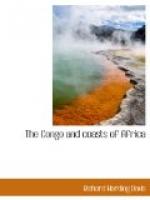“I am not of that Order,” the Father said gravely. He was speaking in English, and added, as though he expected some one to resent it: “We are Jesuits.” No one resented it, and he added: “We have our Order in your country. Do you know Fordham College?”
Did I know it? If you are trying to find our farm, the automobile book tells you to leave Fordham College on your left after Jerome Avenue.
“Of course, I know it,” I said. “They have one of the best baseball nines near New York; they play the Giants every spring.”
The Reverend Father started.
“They play with Giants!” he gasped.
I did not know how to say “baseball nines” in French, but at least he was assured that whatever it was, it was one of the best near New York.
Then Captain Jensen’s little black boy ran up to tell me the steamer was waiting, and began in Bangalese to beg something of the Father. The priest smiled and left us, returning with a rosary and crucifix, which the boy hung round his neck, and then knelt, and the red-bearded Father laid his fingers on the boy’s kinky head. He was a very happy boy over his new possession, and it was much coveted by all the others. One of the black mammies, to ward off evil from the little naked baby at her breast, offered an arm’s length of blue cloth for “the White Man’s fetish.”
[Illustration: The Jesuit Brothers at the Wombali Mission.]
My voyage up the Kasai ended at Dima, the headquarters of the Kasai Concession. I had been told that at Dima I would find a rubber plantation, and I had gone there to see it. I found that the plantation was four days distant, and that the boat for the plantation did not start for six days. I also had been told by the English missionaries at Dima, that I would find an American mission. When I reached Dima I learned that the American mission was at a station further up the river, which could not be reached sooner than a month. That is the sort of information upon which in the Congo one is forced to regulate his movements. As there was at Dima neither mission nor plantation, and as the only boat that would leave it in ten days was departing the next morning, I remained there only one night. It was a place cut out of the jungle, two hundred yards square, and of all stations I saw in the Congo, the best managed. It is the repair shop for the steamers belonging to the Kasai Concession, as well as the headquarters of the company and the residence of the director, M. Dryepoint. He and Van Damme seemed to be the most popular officials in the Congo. M. Dryepoint was up the river, so I did not meet him, but I was most courteously and hospitably entertained by M. Fumiere. He gave me a whole house to myself, and personally showed me over his small kingdom. All the houses were of brick, and the paths and roads were covered with gravel and lined with flowers. Nothing in the Congo is more curious than this pretty town of suburban




